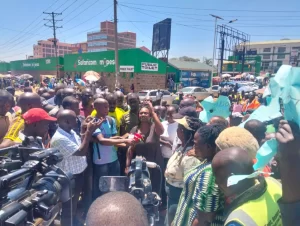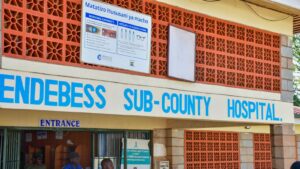
An image showing Endebess Level 4 sub county hospital.Photo/Robert Wanyonyi/Credits

BY ROBERT WANYONYI
During a comprehensive tour of transformative infrastructure projects in the North Rift region,Former ICT Cabinet Secretary Eliud Owallo inspected numerous developments aimed at enhancing public services, trade, and economic growth.
Among the flagship projects is the Siyoi-Muruny Dam in Pokot South Constituency, which is poised to supply clean water to over 350,000 households by 2035. This vital resource will significantly improve water access and resilience in the region. In Kapenguria, the Makutano Sewerage Project is set to provide sanitation services to more than 650 households and institutions, marking a major step toward improved public health.
The 72.3 km Kitale-Murpus road, part of the Kenya-South Sudan Link, is a KSh 15.4 billion investment traversing Trans Nzoia and West Pokot counties. It will not only enhance regional connectivity but also support industrial operations such as the Sebit Clinker Factory in Ortum.

At the Kenya-Uganda border, the Suam One-Stop Border Post in Endebess Sub-County is nearing completion. It is expected to streamline cross-border trade and strengthen ties with Uganda, the Democratic Republic of Congo, and South Sudan. Healthcare access is also receiving a boost with the Endebess Level 4 Sub-County Hospital, which will offer improved maternal, neonatal, and child health services, advancing the goal of universal health coverage.
Education and skills development are being prioritized through the Kwanza Technical and Vocational College, which will accommodate over 500 trainees, preparing youth for the job market.
Finally, the Bikeke ESP Market in Kiminini Sub-County is set to energize local commerce with modern amenities, including cold storage and WiFi, empowering traders and small businesses.

The various projects highlight the government’s steadfast commitment to fostering inclusive development and promoting regional empowerment, all under the leadership of Owallo. By addressing the diverse needs of underrepresented communities and investing in local infrastructure, these initiatives aim to create equitable opportunities for all citizens. This approach not only strengthens regional economies but also ensures that the voices of marginalised populations are heard and considered in the decision-making process, thereby reinforcing the foundation for sustainable growth and community resilience.




